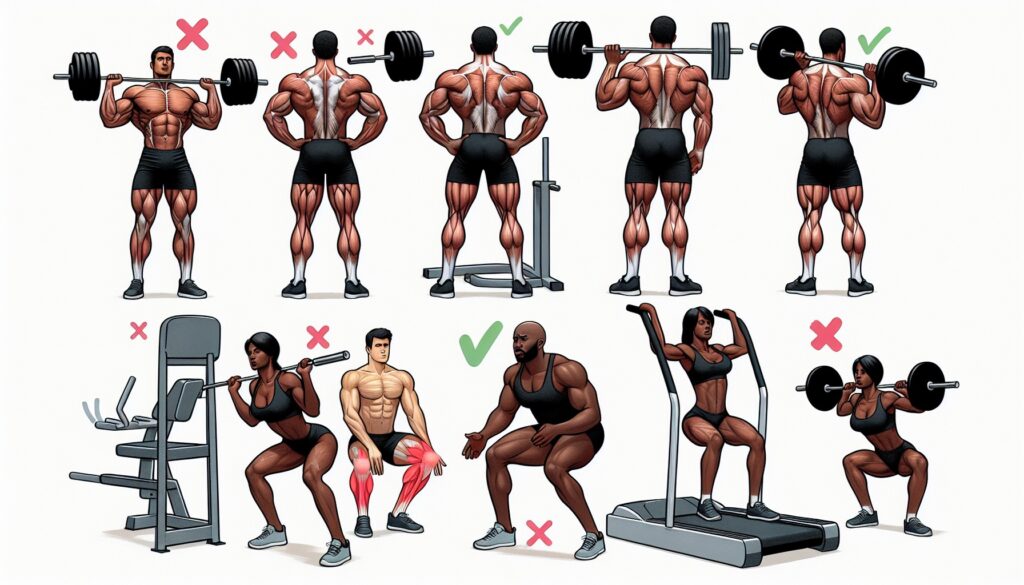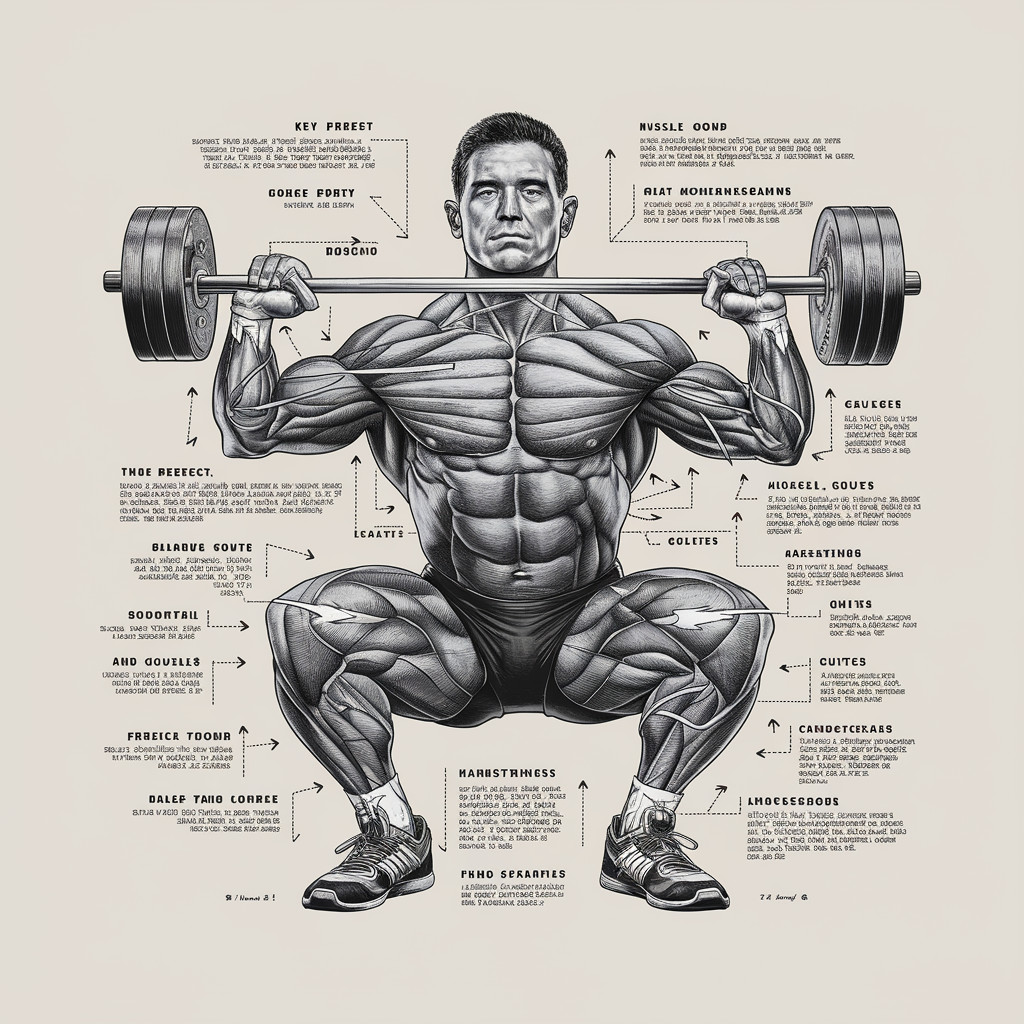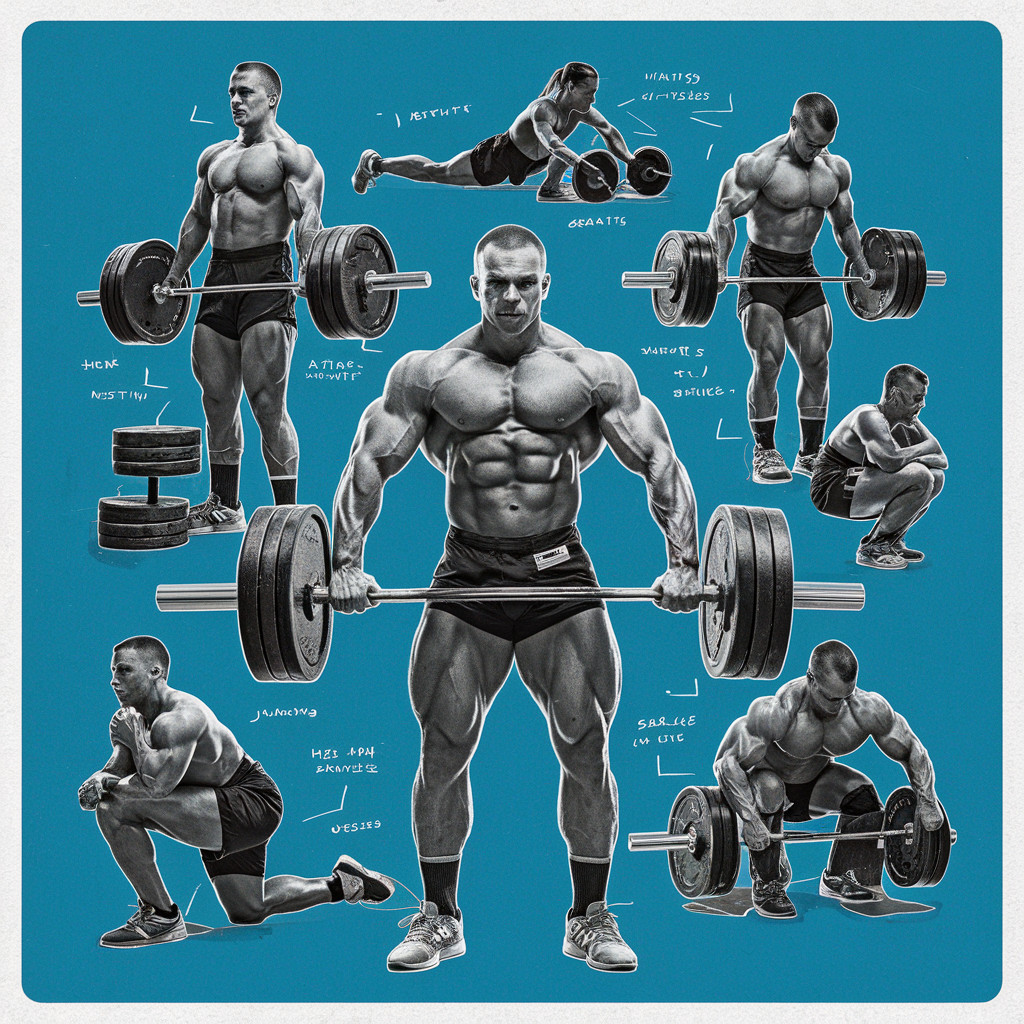Form Precision: Tackling Bodybuilding Form Errors Head-On
Discover common bodybuilding form errors and learn how to perfect your technique for maximum gains!

Importance of Proper Form in Bodybuilding
Hitting the weights with proper form isn’t just for show. It’s like putting on your safety gear before biking or driving. It cranks up your effectiveness, keeps injuries at bay, and helps you see those gains faster. Anyone serious about their gym routine needs to know why this matters.
Why Correct Form is Critical in Strength Training
Getting your form right when pumping iron ensures you’re working the muscles you mean to. Go bad on the form and your workout might fall flat, missing those target muscles.
Here’s a quick rundown of why nailing your form is a must:
| Benefit | What it Means |
|---|---|
| Muscle Activation | Hits the right muscles for that growth |
| Injury Prevention | Keeps those nasty strains and sprains away |
| Improved Performance | Boosts strength gains and those sweet results |
| Long-term Sustainability | Promotes safer, more efficient training |
For more on the myths lurking in weightlifting, check out our piece on weightlifting misconceptions.
Impact of Form Errors on Progress
Messing up your form can really put a wrench in your bodybuilding plans. Bad habits can lead to lopsided muscle growth, bring your progress to a screeching halt, or even sideline you with an injury. These hurdles might make you second guess your commitment to fitness.
Here’s a look at what can go wrong and the consequences:
| Form Error | What Could Go Wrong |
|---|---|
| Rounded Back During Deadlifts | You’re playing with fire for back injuries |
| Rounding Shoulders During Presses | Limits shoulder power and stability |
| Arching Back During Bench Press | Invites lower back troubles that drag down performance |
| Incorrect Squat Depth | Leaves your leg muscles out in the cold |
Want to steer clear of common bodybuilding blunders? Take a peek at our article on common bodybuilding errors. Know these little details, and you’re on your way to better, safer workouts.
Common Form Errors to Avoid
Nailing the right form during workouts ain’t just about showing off; it’s crucial for getting those gains and keeping injuries at bay. Check out these common mistakes you should dodge when pumping iron.
Rounded Back During Deadlifts
Nobody wants a busted spine, right? Having a rounded back while you’re deadlifting can do a number on your back. It often hits when you forget to involve your core and hips properly.
| Right Posture | Oops! Wrong Posture |
|---|---|
| Spine nice and neutral with your chest high | Back’s all rounded like a question mark |
| Core is in gear | Core’s on a break |
Rounding Shoulders During Overhead Press
Shrugging your shoulders like a turtle during an overhead press can mess with your shoulder steadiness and crank up injury risks. You gotta keep those blades pulled back and down for a smooth lift.
| Right Posture | Oops! Wrong Posture |
|---|---|
| Shoulders are back and down | Shoulders playing peekaboo with your ears |
| Elbows slightly ahead of the bar | Elbows acting like wings, flaring out |
Arching Back During Bench Press
Your back’s got no business bending like a cat stretching during a bench press. It can mess with your shoulders and lower back. Lay flat against the bench and hold that natural arch tight.
| Right Posture | Oops! Wrong Posture |
|---|---|
| Feet steady on the floor | Feet floating or crammed under you |
| A hint of an arch with shoulder blades snug | Back’s playing gymnast with hips up high |
Incorrect Squat Depth
If you’re not breaking that squat low enough, you’re missing out. Hitting parallel or deeper gets those thighs and glutes working like magic, while shallow squats leave muscles feeling lazy.
| Right Posture | Oops! Wrong Posture |
|---|---|
| Thighs level with the floor | Only squatting a smidge |
| Weight balanced just right | Weight wobbling forward onto toes |
Dodging these frequent slip-ups during bodybuilding helps you step up your game. Hungry for more tips on nailing your form? Dive into our articles on common bodybuilding errors and weightlifting technique mistakes. Fixing these screw-ups puts you on the fast track to safer, more effective workouts, setting you up for a future packed with fitness success.

Understanding Proper Body Mechanics
Getting your body mechanics right ain’t just about strutting around the gym like you own the place. It’s about getting the most outta those lifts while dodging injuries. Why strain a muscle or pop a disc when just a little focus on core strength, that ol’ spine of yours, and how you dish out weight can actually make you stronger?
Engaging Core Muscles
Think of your core as your body’s powerhouse. A stable core doesn’t only keep you upright, but it lets the rest of your body flow smooth and steady. Mess this up, and you’re inviting Mr. ‘Ouch’ to every workout party. Here’s how to do it right:
| Core Engagement Techniques | Benefits |
|---|---|
| Bracing the core | Keeps your spine in shape |
| Incorporating compound exercises | Hits all the right muscles at once |
| Practicing planks and variations | Keeps that middle rock-solid |
Get those core exercises in your routine, and keep the injury gremlins at bay. Check out other ways people mess up with weights here.
Maintaining Neutral Spine Alignment
You know how your mom always said to stand up straight? Turns out, she’s got a point, at least when it comes to lifting. Your spine needs to be what it naturally is. Twist it wrong, and you’re more likely to need a chiropractor than a protein shake.
| Spine Positions | Description | Risks |
|---|---|---|
| Neutral Spine | All natural curves intact | Keeps back happy |
| Rounded Spine | Bit curvy like a pretzel | Say hello to pain |
| Overarched Spine | Over the top arch | Ouch, compression alert! |
Where you place each bit of your body matters. Knowing more about typical lifting blunders can save you a lot of pain. Take some time to learn about common bodybuilding errors.
Balancing Weight Distribution
Balance isn’t just an art—it’s a science, especially when you’re hoisting weights. Spread things out evenly; it’ll stop you from toppling over or blaming your shoes for that slip. Weight’s gotta go somewhere, so make sure it’s not all going in one place.
| Weight Distribution Techniques | Importance |
|---|---|
| Even foot placement | Won’t wobble like a jelly |
| Center of gravity awareness | Lifts become power-packed |
| Adjusting stance width | Helps with handling more weight |
It’s all about getting those gains without the pains. Avoid weightlifting bad habits and nail the game of body mechanics, ensuring you’re on a path to greater gym success.
Techniques for Correcting Form Errors
To max out those gym gains and dodge the pitfalls of bad form, folks can lean on a handful of trusty tricks for sharpening up their technique. These methods not only boost performance but also keep those silly injuries at bay during workouts.
Utilizing Mirrors for Feedback
Let’s talk about mirrors. In a gym, they’re more than just for selfie-taking. Mirrors give a clear view of your moves when working out. They show where you might be off-track, helping squash any errors in posture or alignment. Spotting these slip-ups on the spot can go a long way in cutting down the chance of strains or pulls.
When checking yourself out in mirrors, zero in on certain spots like how straight your back is, where your knees are pointing, and if your shoulders are upright. Keep an eye on these things regularly, and you might just find yourself leveling up in no time.
| Key Areas to Observe | Importance |
|---|---|
| Back Position | Keeps your back from bowing or hunching |
| Knee Alignment | Makes sure knees are over toes |
| Shoulder Placement | Staves off any shoulder slumping |
Working with a Trainer
Bringing a pro into the mix can work wonders. Trainers dish out custom pointers and stand by to help tweak your form to perfection. Their seasoned eye spots the errors you might miss, ensuring your training is both safe and effective.
These fitness gurus guide you on the path of escalating your workout adventures without going off the rails. They pinpoint weak spots or faulty form that even the mirror might not reveal. Seeking a trainer’s wisdom is a golden ticket for those serious about smashing their fitness goals and swerving common goofs in bodybuilding.
Video Analysis for Self-Correction
Grab your smartphone and hit record while hitting those weights. Watching your workouts unfold on screen captures what you might overlook in the heat of the moment. Video analysis opens up new perspectives on your moves, giving you a chance to catch and correct what’s not right.
Effective use of video magic means:
- Playing back tricky lifts in slow motion to see every detail
- Stacking your footage against top-notch demonstrations
- Keeping a video log to appreciate just how far you’ve come
This handy tool not only smooths out any current rough spots in your form but also deepens your grasp of avoiding those sneaky weightlifting blunders.
| Benefits of Video Analysis | Examples |
|---|---|
| Enhanced Self-Awareness | Spotting form quirks on replay |
| Comparative Learning | Peeking at how the pros do it |
| Progress Monitoring | Watching the journey of your gains |
Infusing these techniques into your usual routine can set you on the fast track to building serious strength while keeping those pesky injuries at arm’s length.

Progressing Safely in Bodybuilding
Doing well at bodybuilding is all about playing it smart to dodge those pesky injuries and keep the gains coming for the long haul. Check out these common-sense steps that’ll keep you on the right track.
Gradual Increase in Weights
Let’s not go all superhero by loading up the bar too fast. Jumping the gun can leave you wincing and set you back big time. Bump those weights by a tiny 5-10% when you’re nailing the current ones like a champ and your form’s got no wobble.
| Current Weight | Suggested Increment | New Weight |
|---|---|---|
| 100 lbs | 5-10% | 105-110 lbs |
| 150 lbs | 5-10% | 157-165 lbs |
| 200 lbs | 5-10% | 210-220 lbs |
By playing it cool with weight increases, you’re not just getting stronger, you’re getting smart strong. Dive into more classic bloopers to sidestep in our weightlifting misconceptions article.
Listening to Your Body’s Feedback
Your bod’s kind of like a chatty buddy when it comes to lifting. It’s got all sorts of signals—tiredness, soreness, outright “ouch”. Figuring out when to push it and when to back off is huge for making solid progress.
Keep your ear to the ground by:
- Checking how peppy or pooped you feel
- Noticing muscle soreness
- Staying aware of nagging pain during workouts
Knowing your limits is your best defense against injuries, letting you keep on trucking safely. More insights? Check out common bodybuilding errors.
Importance of Rest and Recovery
Taking a break is just as important as hitting the gym. Muscles need time to chill, fix up, and come back stronger. Overdo it, and you’ll be running on empty or even hurt yourself, messing up those gains.
Nail the recovery game with:
- Rest Days: Pencil in those break days in your routine.
- Sleep: Snag enough zzz’s to give muscles a fighting chance.
- Active Recovery: Keep it light on off days with easy moves to keep the blood flowing.
A workout plan with a proper chill schedule means better and consistent results. Want to avoid technique slip-ups? Check out weightlifting technique mistakes for tips.

